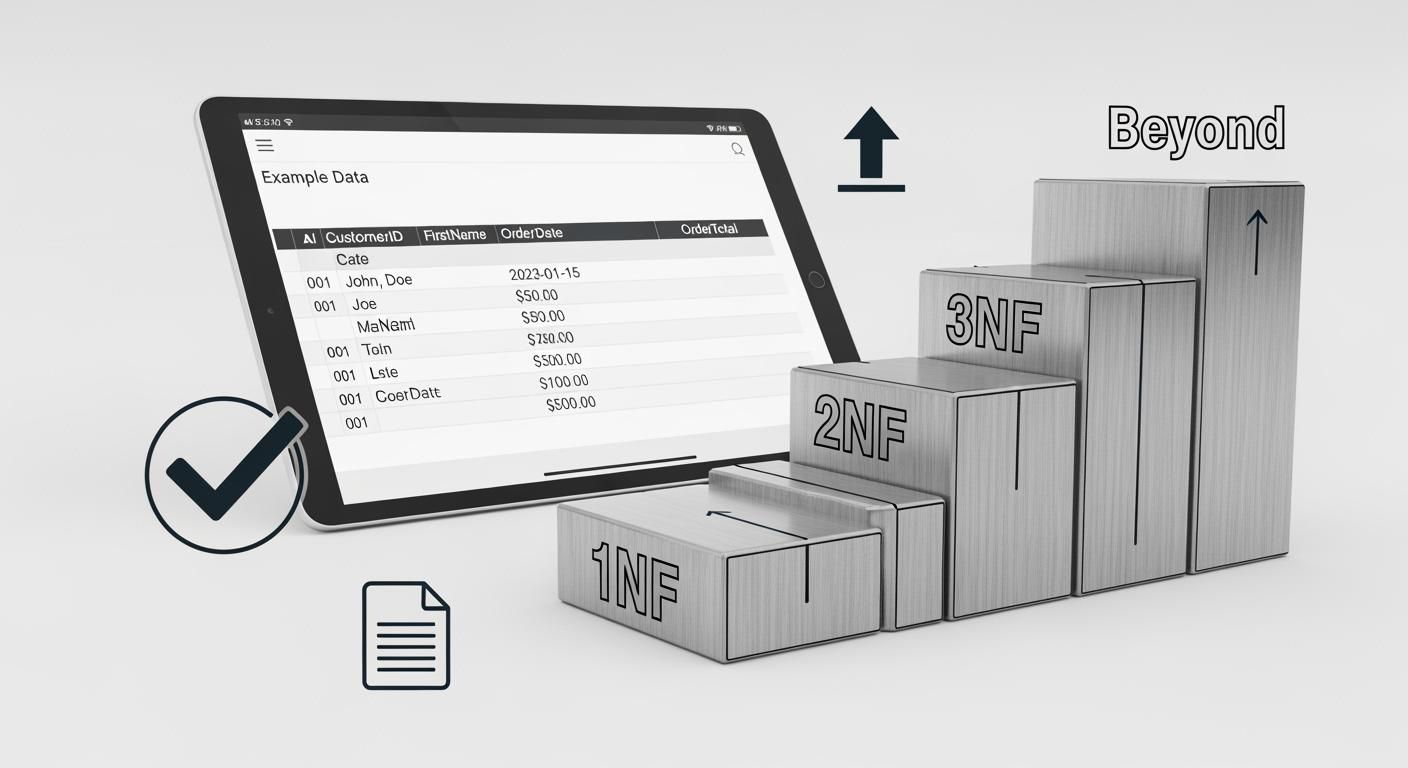A Beginner’s Guide to Database Normalization: 1NF, 2NF, 3NF, and Beyond



Think of database normalization like cleaning your closet. You do not want shirts, shoes, and hats mixed up. You want each thing in its own spot. This helps you find stuff fast and keeps things tidy. Database NF does this for your data. When you use normalization, you stop common problems like:
Insertion anomaly—You cannot add new info without more details.
Deletion anomaly—Taking away one thing deletes something else.
Updation anomaly—You must change the same info in many spots.
With normalization, you have less mess, fewer errors, and easier changes. Your data stays correct, and you spend less time fixing mistakes. A neat database grows with you and is simple to handle.

Image Source: pexels
First Normal Form, or 1NF, is the first way to organize data. Every cell in your table should have only one value. It is like putting one shirt in each cubby. If you put two shirts in one cubby, it gets messy. In databases, each value should be atomic. Atomic means the value cannot be split into smaller parts.
1NF means: “No lists, no groups, no sets—just one value in each cell.”
To make your table follow 1NF, use these rules:
Each column needs a special name.
Each cell must have only one value.
Each row must be different, often with a primary key.
Each column should have the same kind of values.
Do not use repeating groups or arrays in any row.
These rules help you keep your data neat and easy to understand.
Atomic values are simple and single pieces of data. For example, one phone number is atomic. A list of phone numbers in one cell is not atomic. Atomic values help you search, update, and manage data easily. They stop problems like having extra copies and mistakes when updating. Using atomic values gives you a strong start for other Database NF steps.
| Aspect | Description |
|---|---|
| Definition of Atomic Values | Atomic values are single, whole values that cannot be split and still make sense. |
| Importance for 1NF | A table is in 1NF if it has only atomic values. This stops composite values in columns and helps normalization. |
Here is an easy example. Imagine a table for students and their favorite subjects:
| StudentID | Name | FavoriteSubjects |
|---|---|---|
| 1 | Alice | Math, Science |
| 2 | Bob | English |
This table does not follow 1NF. The “FavoriteSubjects” column has more than one value for Alice. To fix this, split the subjects into new rows:
| StudentID | Name | FavoriteSubject |
|---|---|---|
| 1 | Alice | Math |
| 1 | Alice | Science |
| 2 | Bob | English |
Now, each cell has only one value. Your table is in First Normal Form. This change makes your data easier to use and helps you get ready for the next Database NF steps.
You have learned about 1NF, where each cell holds a single value. Now, let’s talk about Second Normal Form, or 2NF. This step in Database NF makes your tables even cleaner. Here’s what you need to know:
Your table must already be in 1NF.
Every non-key column should depend on the whole primary key, not just part of it.
If you use a composite key (more than one column as the primary key), you need to check if any column depends only on part of that key. If it does, your table is not in 2NF.
2NF helps you remove partial dependencies. This means every piece of data connects to the whole key, making your database stronger and easier to manage.
Full functional dependency is a big idea in Database NF. It means that each non-key column relies on the entire primary key. If a column depends on just one part of a composite key, you get problems like repeated data and mistakes when updating.
Full functional dependency keeps your data tidy.
It stops partial dependencies, which can cause errors.
You get less redundancy and better data integrity.
Let’s look at a table that breaks the rules of 2NF. Imagine you have a table called Courses1:
| CourseID | Department | Lecturer | Textbook |
|---|---|---|---|
| 101 | Math | Smith | Algebra Book |
| 102 | Science | Lee | Biology Book |
Here, suppose CourseID and Department together make the primary key. If Lecturer depends only on Department, not the whole key, you have a partial dependency.
To fix this, split the table into two:
| Courses2 |
|---|
| CourseID |
| 101 |
| 102 |
| CourseTextbooks |
|---|
| CourseID |
| 101 |
| 102 |
Now, every non-key column depends on the whole primary key. You have reached Second Normal Form. Your Database NF journey gets easier, and your tables stay neat.

Image Source: pexels
You reach Third Normal Form when your table is in 2NF. Every non-key column should only depend on the primary key. No column should rely on another non-key column. This step gets rid of transitive dependencies. Your data becomes even cleaner.
| Condition | Description |
|---|---|
| 1. Second Normal Form (2NF) | The table must already be in 2NF. |
| 2. Non-transitive Dependency | Non-key columns depend only on the primary key, not on other non-key columns. |
A table is in 3NF if:
It is in 2NF.
There are no transitive dependencies for non-key columns.
Every non-key column should connect right to the primary key. If a column depends on another non-key column, your data can get messy. You might see errors. 3NF helps you stop this problem. Each piece of data links straight to the main key.
| Criteria for 3NF | Description |
|---|---|
| Non-key attribute dependency | Non-key columns depend only on the primary key. |
| Elimination of redundancy | Data stays unique and accurate. |
Sometimes, you need stricter rules for big databases. BCNF makes sure every determinant is a candidate key. 4NF and 5NF help with harder relationships. These include many-to-many links and multivalued dependencies. Higher forms keep your data correct. They help you avoid mistakes in large systems.
| Aspect | Third Normal Form (3NF) | Boyce-Codd Normal Form (BCNF) | Fourth Normal Form (4NF) | Fifth Normal Form (5NF) |
|---|---|---|---|---|
| Definition | Removes transitive dependencies | Every determinant is a candidate key | Handles multivalued dependencies | Handles complex join dependencies |
| Strictness | Moderate | High | Higher | Highest |
| Use Case | Most business tables | Complex keys | Many-to-many relationships | Advanced data models |
As your database gets bigger, higher normal forms help you keep data neat. They make relationships easy to see.
Let’s look at a simple example:
| Step | Description |
|---|---|
| 1 | Start with atomic values (1NF). |
| 2 | Make sure all non-key columns depend on the whole key (2NF). |
| 3 | Remove columns that depend on other non-key columns (3NF). |
Common Pitfalls:
Over-normalization makes tables hard to use.
Too many joins can slow down your searches.
Ignoring business needs makes designs confusing.
Forgetting to write down changes causes problems later.
Best Practices:
Find your main data groups.
Make clear tables and primary keys.
Normalize step by step, but stop if it gets too hard.
Always think about how people will use your data.
Write down your design choices.
Normalization keeps your data neat, but you need to balance it with speed. Use these steps to build strong databases.
You now know that normalization helps keep your database tidy and simple to use. Here are some good things about it:
| Benefit | Description |
|---|---|
| Improved organization | Your data is sorted well and does not repeat much. |
| Data consistency | Everyone sees the same data, so your team works together better. |
| Reduces redundancy | Your files get smaller and your computer works faster. |
| Cost reduction | You use less space and save time and money. |
| Increased security | Neat data helps keep your database safe. |
When you use 1NF, 2NF, and 3NF, you get rid of nested data, stop repeating things, and make your data stronger. Want to know more? Try these helpful guides:
Data Normalization: A Practical Guide for Beginners
Advanced Data Normalization Techniques
Keep working on these steps. You will make databases that are stronger, quicker, and work better every time! 🚀
Database normalization means you organize your data so each piece has its own spot. You avoid repeating information. This makes your database easier to use and keeps your data correct.
You use these steps to keep your data neat. They help you avoid mistakes, save space, and make updates simple. Each step fixes a different kind of problem.
You should not skip steps. Each normal form builds on the last one. If you skip, you might end up with messy data or errors.
Sometimes, yes. If you split your data into too many tables, searches can take longer. You need to balance neat data with speed.
Stop when your data is easy to use and fits your needs. If more steps make things harder, you can stop. Always think about how you will use your data.
SQLFlash is your AI-powered SQL Optimization Partner.
Based on AI models, we accurately identify SQL performance bottlenecks and optimize query performance, freeing you from the cumbersome SQL tuning process so you can fully focus on developing and implementing business logic.
Join us and experience the power of SQLFlash today!.